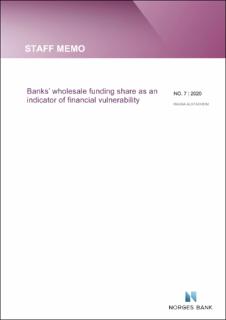| dc.contributor.author | Alstadheim, Ragna | |
| dc.date.accessioned | 2020-09-22T08:06:46Z | |
| dc.date.available | 2020-09-22T08:06:46Z | |
| dc.date.issued | 2020 | |
| dc.identifier.isbn | 978-82-8379-158-7 | |
| dc.identifier.issn | 1504-2596 | |
| dc.identifier.uri | https://hdl.handle.net/11250/2678935 | |
| dc.description.abstract | A review of theoretical links between the wholesale (or market) funding share of banks (WFS) and financial vulnerability is provided. The vulnerability may both be within the financial system, and in the non-financial sector. The historical development of the WFS in Norway is described. In light of theory and history, we provide an intuitive interpretation of why the WFS works well as an indicator of excessive credit growth in the non-financial sector and as a predictor of financial crises. We argue that other indicators, such as net aggregate household savings and households’ net financial investments, may have more intuitive links to excessive gross credit growth. These indicators predict the WFS in Norway. | en_US |
| dc.language.iso | eng | en_US |
| dc.publisher | Norges Bank | en_US |
| dc.relation.ispartofseries | Staff Memo;7/2020 | |
| dc.rights | Attribution-NonCommercial-NoDerivatives 4.0 Internasjonal | * |
| dc.rights.uri | http://creativecommons.org/licenses/by-nc-nd/4.0/deed.no | * |
| dc.title | Banks’ wholesale funding share as an indicator of financial vulnerability | en_US |
| dc.type | Working paper | en_US |
| dc.description.version | publishedVersion | en_US |
| dc.subject.nsi | VDP::Samfunnsvitenskap: 200::Økonomi: 210::Samfunnsøkonomi: 212 | en_US |
| dc.source.pagenumber | 17 | en_US |

